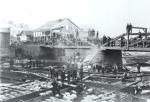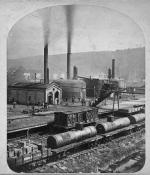![header=[Marker Text] body=[The first refinery in the Oil Creek Region for crude petroleum was built nearby in 1860. The first run of oil was made in 1861. Oil was first refined at Pittsburgh, about 1854, by Samuel Kier.
] sign](kora/files/1/10/1-A-B1-139-ExplorePAHistory-a0a4w7-a_450.gif)
Mouse over for marker text
Name:
Early Refinery
Region:
Lake Erie Region
County:
Crawford
Marker Location:
East Main Street (PA 27), Titusville
Dedication Date:
September 29, 1954
Behind the Marker
William H. Abbott is credited with mastering the oil refining process. After purchasing a farm near Titusville and settling in the region he arranged for the marketing of oil with a New York distributor and worked with chemist George M. Mowbray to perfect the refining process.
Abbott's refinery included machinery, tanks, acids, and chemicals. His first successful refinement was completed on January 22, 1861. Oil could, henceforth, be prepared for sale without leaving the region.
Other refiners soon followed his example. Samuel Downer constructed a large refining works in a nearby town in 1861. The main building was two stories high and three hundred and ten feet long. Five or six other buildings comprised the remainder of the site. Twelve stills were in operation with twenty-five tanks that could hold up to thirty thousand barrels. Within a few years, the capacity had risen to one million gallons per year.
As a "boom" emerged in the oil industry, most crude was shipped out of the Oil Creek area to be processed in Pittsburgh or Cleveland, Ohio.
Abbott's refinery included machinery, tanks, acids, and chemicals. His first successful refinement was completed on January 22, 1861. Oil could, henceforth, be prepared for sale without leaving the region.
Other refiners soon followed his example. Samuel Downer constructed a large refining works in a nearby town in 1861. The main building was two stories high and three hundred and ten feet long. Five or six other buildings comprised the remainder of the site. Twelve stills were in operation with twenty-five tanks that could hold up to thirty thousand barrels. Within a few years, the capacity had risen to one million gallons per year.
As a "boom" emerged in the oil industry, most crude was shipped out of the Oil Creek area to be processed in Pittsburgh or Cleveland, Ohio.
Beyond the Marker






